 Research Article
Research Article
Research on Dynamic Characteristics of Double-Layer Continuous Plate-Truss Composite Bridge with Three Main Trusses
Chen Kongliang1* and Wang Ronghui2
1School of Civil Architecture, Wuyi University, Jiangmen, 529000, China
2South China University of Technology, Guangzhou 510640, Guangdong, China
Chen Kongliang, School of Civil Architecture, Wuyi University, Jiangmen, 529000, China.
Received Date:September 01, 2022; Published Date: September 19, 2022
Abstract
Aiming at the dynamic characteristics of the plate-truss composite bridge, the effects of the thickness of the deck, the stiffness of the main truss chord, the overall stiffness of the main truss, the stiffness of the longitudinal beam, the stiffness of the transverse beam, and the stiffness of the parallel connection on the lateral stiffness of the structure were studied by the finite element method. The results show that increasing the thickness of the bridge deck is conducive to improving the overall stiffness of the structure, enhancing the overall stiffness of the main truss is conducive to improving the torsional stiffness of the structure, and enhancing the stiffness of the longitudinal beam is conducive to improving the vertical stiffness of the structure.
Keywords:Plate-truss composite bridge; Combined beam; Dynamic characteristics; Bridge deck; Stiffness
Introduction
The dynamic characteristics of bridge structures are important parameters in dynamic performance analysis, including structural natural vibration frequency, mode shape etc., which reflect the stiffness index of bridges [1-5]. The dynamic characteristics of bridge structures depend on the composition system, stiffness, mass distribution and support boundary conditions of the structure. It is of great significance for the correct seismic design, vehicle vibration analysis, wind stability analysis and maintenance of bridge structures. The three main truss double-layer continuous plate truss composite bridge has a novel structure, which is composed of three main trusses. Because of the new bridge type, there are few domestic research results on this type of bridge, so it is very important to study the performance. In this paper, a threemain truss double-layer continuous slab truss composite bridge is used as a project, and the dynamic characteristics of this type of bridge type are studied by combining the characteristics of the beam [6-9], which is the basis for the future structural seismic design and anti-corrosion characteristics of this type of bridge type, and for wind stability analysis and other dynamic analysis provide an important reference.
Project Example
Dongguan Dongjiang Bridge is a three main truss rigid suspension stiffened continuous steel truss girder bridge with concrete deck. The main truss section of the bridge is 16m long, the upper and lower truss heights are 10m, and the internode length is 8m. The bridge deck is composed of longitudinal, transverse beams and concrete slabs. The concrete slabs are combined with the longitudinal and transverse beams.
Finite element model is shown as Figure 1. Due to the wide bridge deck, the influence of the bridge deck system on the structural stiffness is considered in the dynamic analysis process, and the flexural stiffness and torsional stiffness of elements such as chords, inclined webs, and vertical bars are calculated according to the actual section, and the longitudinal beams and transverse beams are calculated according to the actual section. The combined beam element is formed with the bridge deck, and the section characteristics of the combined beam adopt the equivalent section stiffness model, and the boundary conditions are consistent with those of the continuous beam.
Figure 1:Finite element model.
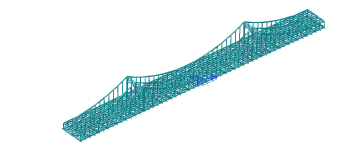
Analysis of Dynamic Characteristics
The dynamic calculation method in this paper adopts the subspace iteration technique, which adopts the generalized Jacobi iterative algorithm, and adopts the complete stiffness matrix and mass matrix, which has high solution accuracy and is suitable for the modal analysis of large-scale structures. According to the principle of finite element method, the solution of the three-dimensional free vibration equation of the structure can be expressed as (1)-(7)

Repeat the calculation according to the above calculation process until sufficient accuracy is achieved, and then the ideal frequency and mode shape can be obtained. Where: [X] is the initial mode shape; {A} is the undetermined column vector; [M], [K] are the overall mass matrix and overall stiffness matrix of the structure, respectively.
From the comparison of the results in Table 1, the vertical frequency is consistent with the measured results. The first-order cross bend frequency is 13% smaller than the measured value, the first-order twist frequency is 13% smaller than the measured value. From the comparison of the results, the vertical stiffness of the structure is weak, and the torsional stiffness of the structure is large. The comparison of modal parameters such as vibration frequency and mode shape show that the physical parameters such as torsion resistance, vertical bending stiffness and symmetry of Dongjiang Bridge are in good condition.
Table 1:Comparison of modal results.

Unit: Hz
Influence of Parameters on Natural Vibration Characteristics
The dynamic characteristics of this type of bridge are studied by changing the component parameters of the plate-truss composite structure. The research parameters are respectively the thickness of the bridge deck, the stiffness of the main truss chord, the overall stiffness of the main truss, the stiffness of the longitudinal beam, the stiffness of the transverse beam, and the stiffness of the parallel connection.
Variation in deck thickness
Figure 2:First-order frequency results of slab thickness diversification.
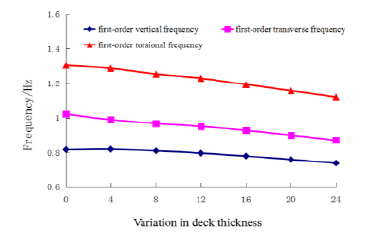
The stiffness of the bridge deck is one of the important parameters affecting the dynamic characteristics of the platetruss composite structure. The natural frequency of the bending vibration, the natural frequency of the first-order transverse bending vibration, and the natural frequency of the first-order bending-torsional vibration are shown in Figure 2. The natural frequency of the first-order vertical bending vibration, the firstorder transverse bending vibration The natural frequency and the natural frequency change curve of the first-order bending-torsional vibration basically satisfy the linear decreasing relationship.
Variation of main chord stiffness
When the stiffness of the three main truss chords changes according to the multiples of 1, 5, 10, 15, 20, and 25, the curve is shown in Figure 3. The natural frequency of the first-order vertical bending vibration, the natural frequency of the firstorder transverse bending vibration, and the natural frequency of the first-order torsional vibration are basically satisfying a linear relationship.
It can be found from Figure 3 that when the main truss chord increases according to the multiple shown in the figure, the natural vibration frequency corresponding to the first-order vertical bending vibration and the first-order transverse bending vibration increases relatively gently when the stiffness of the main truss chord increases from 1 to 25 times. The change has little effect on the lateral stiffness and vertical stiffness of the overall structure. Increasing the stiffness of the main truss chord will increase the torsional stiffness of the overall structure, but the effect is not obvious.
Figure 3:First-order frequency results of main truss chord stiffness diversification.
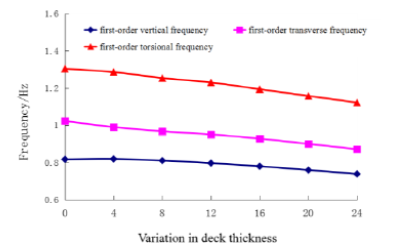
Overall stiffness of main truss/
When the overall stiffness of the three main trusses changes respectively according to the multiples of 1, 5, 10, 15, 20, and 25, the natural frequencies of the first-order vertical bending vibration, first-order transverse bending vibration, and first-order torsional vibration corresponding to the structure The change curves are shown in Figure 4. The natural frequency change curves of the firstorder vertical bending vibration, the first-order transverse bending vibration, and the first-order torsional vibration basically satisfy a linear increasing relationship.
It can be found from Figure 4 that when the main truss increases according to the multiple shown in the figure, the natural frequency curve corresponding to the first-order vertical bending vibration and the first-order transverse bending vibration increases relatively gently, and the slope of the natural frequency curve corresponding to the first-order torsional vibration is relatively large.
Figure 4:First-order frequency results of main truss stiffness diversification.
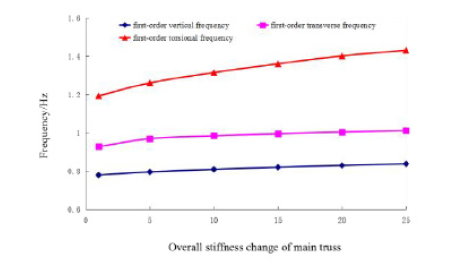
Variation in Stringer stiffness
When the stiffness of the longitudinal beam changes according to the multiples of 1, 5, 10, 15, 20, and 25, the corresponding firstorder vertical bending vibration, first-order transverse bending vibration, and first-order torsional vibration of the structure correspond to the natural vibration frequency curve as shown in the figure. As shown in Figure 5, the natural frequency change curves of the first-order vertical bending vibration, the first-order transverse bending vibration, and the first-order torsional vibration basically satisfy a linear increasing relationship.
It can be found from Figure 5 that when the longitudinal beam increases according to the magnification shown in the figure, the natural vibration frequency corresponding to the first-order transverse bending and the first-order torsion of the structure increases relatively gently, and the natural vibration frequency corresponding to the first-order vertical bending vibration increases relatively large. The stiffness change of the longitudinal beam has a relatively obvious influence on the vertical stiffness of the structure, but the influence on the transverse bending stiffness and torsional stiffness of the structure is relatively small. Adjusting the stiffness of the longitudinal beam can improve the vertical stiffness of the structure.
Figure 5:First-order frequency results of Longitudinal stiffness diversification.
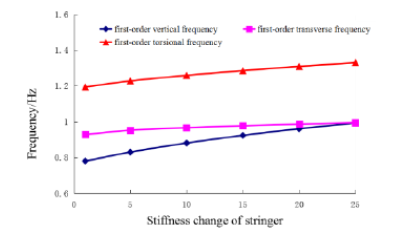
Variation in beam stiffness
When the beam stiffness changes according to the multiples of 1, 5, 10, 15, 20, and 25, respectively, the natural frequency change curves of the first-order vertical bending vibration, the firstorder transverse bending vibration, and the first-order torsional vibration of the structure are shown in Figure 6. It is shown that the natural frequency change curves of the first-order vertical bending vibration, the first-order transverse bending vibration and the first-order torsional vibration basically satisfy the linear increasing relationship. It can be found from Figure 6 that when the beam stiffness increases by the multiple shown in the figure, the natural vibration frequencies corresponding to the first-order vertical bending vibration, the first-order transverse bending vibration, and the first-order torsional vibration increase relatively gently, and the beam stiffness increases while the vertical stiffness, lateral stiffness and torsional stiffness of the structure have little effect.
Figure 6:First-order frequency results of crossbeam stiffness disiversification.

Variation in parallel stiffness
When the stiffness of the parallel connection changes according to the multiples of 1, 5, 10, 15, 20, and 25, the corresponding firstorder vertical bending vibration, first-order transverse bending vibration, and first-order torsional vibration of the structure correspond to the natural vibration frequency curve as shown in the figure. As shown in Figure 7, the natural frequency change curves of the first-order vertical bending vibration, the first-order transverse bending vibration, and the first-order torsional vibration basically satisfy a linear relationship. It can be found from Figure 7 that when the stiffness of the parallel coupling increases according to the magnification shown in the figure, the corresponding frequency increases of the first-order vertical bending vibration, transverse bending vibration and torsional vibration are quite small. It shows that the influence of the stiffness change of the parallel coupling on the vertical stiffness and torsional stiffness of the structure can be ignored.
Figure 7:First -order frequency results of cross joint stiffness siversification.
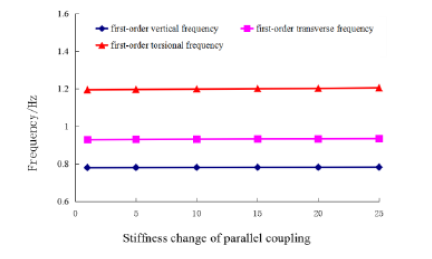
Conclusion
From the above analysis, the following conclusions can be
drawn:
• The change of the bridge deck thickness has a relatively
large influence on the natural vibration frequency of the
composite structure and has a relatively obvious influence
on the changes of the vertical stiffness, lateral stiffness and
torsional stiffness of the overall structure.
• The change of the stiffness of the main truss chord has
relatively little effect on the first-order vertical bending and
transverse bending frequencies but has a relatively large effect
on the first-order torsional frequency. Increasing the stiffness
of the main truss chord will increase the torsional stiffness of
the structure.
• The change of the overall stiffness of the main truss
has a relatively large influence on the first-order torsional
frequency and has an effect on the vertical bending stiffness
and transverse bending stiffness of the structure. The noise
is not obvious, but the impact on the torsional stiffness of the
structure is relatively large.
• The change of longitudinal beam stiffness has a relatively
large influence on the vertical frequency of the structure,
and the vertical bending stiffness of the composite structure
is relatively large, but for the lateral stiffness, the torsional
stiffness is relatively weak.
Acknowledgement
None.
Conflict of Interest
No conflict of interest.
References
- Liu Airong, Zhang Junping, Yu Qicai, et al. (2007) Study on dynamic properties and traveling wave effect of Xinguang Bridge. Journal of Guangzhou University 6(4): 74-80.
- B Zuada Coelho, AHJM Vervuurt, WHA Peelen, JS Leendertz (2013) Dynamics of modular expansion joints: The Martinus Nijhoff Bridge. Engineering Structures 48: 144-154.
- Ren Weixin, Peng Xuelin, Lin Youqin (2005) Experimental and analytical studies on dynamic characteristics span cable-stayed bridge. Engineering Structures 27: 535-548.
- Zhang Tianyu, Zhong Xingu, Yu Congcong (2019) Dynamic characteristic analysis for Maurer bridge expansion joints. Chinese Journal Of Applied Mechanics 36(4): 847-855.
- Pan Cunrui (2018) Analysis on Dynamic Property of Steel-concrete Composite Bridge Based on Measured Data. Urban Roads Bridges and Flood Control 12(12): 70-76.
- Amjad J Aref, Methee Chiewanichakorn, Stuart S Chen, Il-Sang Ahn (2007) Effective slab width definition for negative moment regions of composite bridges. Journal of Bridge Engineering 12(3): 339-349.
- Castro JM, Elghazouli AY, Izzuddin BA (2007) Assessment of effective slab widths in composite beams. Journal of Constructional Steel Research 63: 1317-1327.
- Il-Sang Ahn, Methee Chiewani Chakorn, Stuart S Chen, Amjad J Aref (2004) Effective flange width provisions for composite steel bridges. Engineering Structures 26: 1843-1851.
- Razaqpur A Ghani, Esfandiari Afshin (2006) Redistribution of longitudinal moments in straight, continuous concrete slab-Steel girder composite bridges. Canadian Journal of Civil Engineering 33(4): 471-488.
-
Chen Kongliang* and Wang Ronghui. Research on Dynamic Characteristics of Double-Layer Continuous Plate-Truss Composite Bridge with Three Main Trusses. Glob J Eng Sci. 10(1): 2022. GJES.MS.ID.000729
-
Plate-truss composite bridge, Combined beam, Dynamic characteristics, Bridge deck, Stiffness
-

This work is licensed under a Creative Commons Attribution-NonCommercial 4.0 International License.






